Nuclear era. Part 6
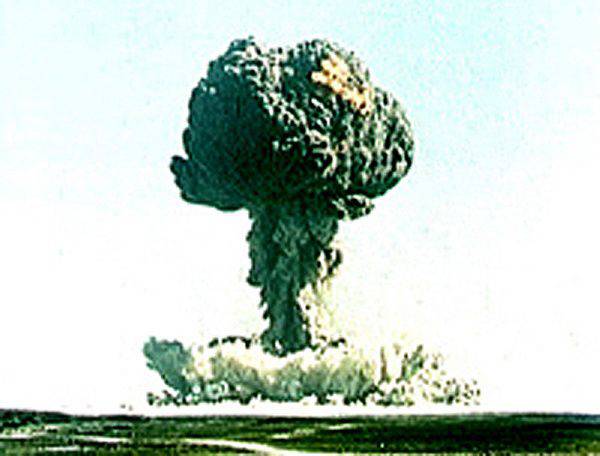
China
Until the beginning of the 60s of the last century, close allied relations were maintained between the USSR and the PRC, and our countries conducted close military-technical cooperation. Significant amounts of weapons were delivered from the Soviet Union to China - missile, aviation and armored vehicles. Licenses were transferred and assistance was provided in the production of the most modern models of military equipment and weapons at that time. In exchange for the USSR were: agricultural products, consumer goods, non-ferrous metals and silver.
But at the request of the Chinese leadership for the supply of nuclear weapons invariably followed an unequivocal categorical refusal. Nevertheless, it is difficult to overestimate the role of the USSR in the creation of the Chinese atomic bomb. Even taking into account the fact that the Chinese have walked on their own to go all the way to build nuclear potential, without thousands of scientists and specialists trained and trained in the Soviet Union, and without the supply of scientific and special equipment, the implementation of the Chinese nuclear project would be hardly possible. Technological and scientific documentation on issues of interest to Chinese specialists was also transferred. Until the time of exacerbation of relations between our countries, the Chinese still managed to obtain a sufficient amount of theoretical information, which allowed them to avoid many mistakes and dead ends in research.
At the end of 1956, the Third Ministry of Mechanical Engineering was created to implement the atomic program in the PRC. The turning point for the Chinese nuclear program was 1958, then, with the help of the USSR, construction of uranium enrichment plants began in Baotou, Hengyang, Jiuqiang, Lanzhou and the first Chinese experimental heavy water nuclear reactor and cyclotron were launched. Mining of uranium ore was carried out in the mines: Dapu, Chenxiang, Henshan and Shangrao. A radiochemical plant was built in Jiuquan, where plutonium extraction began. In addition to the production base, with Soviet assistance, research centers and laboratories were created, such as the Northwest Arms Development Center in Qinghai and the Beijing Institute for Nuclear Research. A railway branch was laid in the Xinjiang Uygur Autonomous Region, which made it possible to create a similar testing ground of the same name northwest of the Salt Lake Lobnor. At the beginning of 60, Chinese physicists conducted more than a thousand full-scale explosive experiments, simulating and investigating the processes that occur when a nuclear charge is detonated.
In the 1960 year, due to the deterioration of bilateral relations, all Soviet specialists who worked in the Chinese nuclear program left the PRC. But by that time, most of the work on nuclear issues either entered the final stage, or advanced far enough, and the departure of Soviet consultants to their homeland did not change much.
After the end of the Korean War and the Taiwan crisis, during which the US repeatedly threatened to use an atomic bomb against China, the Chinese leadership, despite the extremely low standard of living of the population, spent enormous resources on a national nuclear program. According to the CIA, the creation of a nuclear weapon cost China $ 4,1 billion, at the rate of the beginning of the 60-s. About 900 enterprises and organizations were involved in the work on the nuclear project. Mao Zedong believed that without China’s possession of nuclear weapons, the whole world would treat China with disdain. In particular, he said: “In the current world, we cannot do without this thing, if we want it not to offend us”.
In the second half of 1964, specialists from the Jiuquan nuclear complex began assembling the first nuclear charge. The long-awaited moment for the Chinese leaders was 16 on October 1964, when an experimental nuclear charge (project “102”) based on uranium-596, 235 CT was exploded at the Lobnor test site, on a metal tower with a height of 22 meters. On the same day, State Council Premier Zhou Enlai told the Chinese people and the whole world about the successful testing of the first atomic bomb in China.
The nuclear tests in the PRC came as a surprise to the American intelligence services. According to their reports, it was not until the 1969 of the year that the appearance of the Chinese atomic bomb would be expected. However, with the forecasts on the timing of the creation of Soviet nuclear weapons, the Americans also made a mistake.
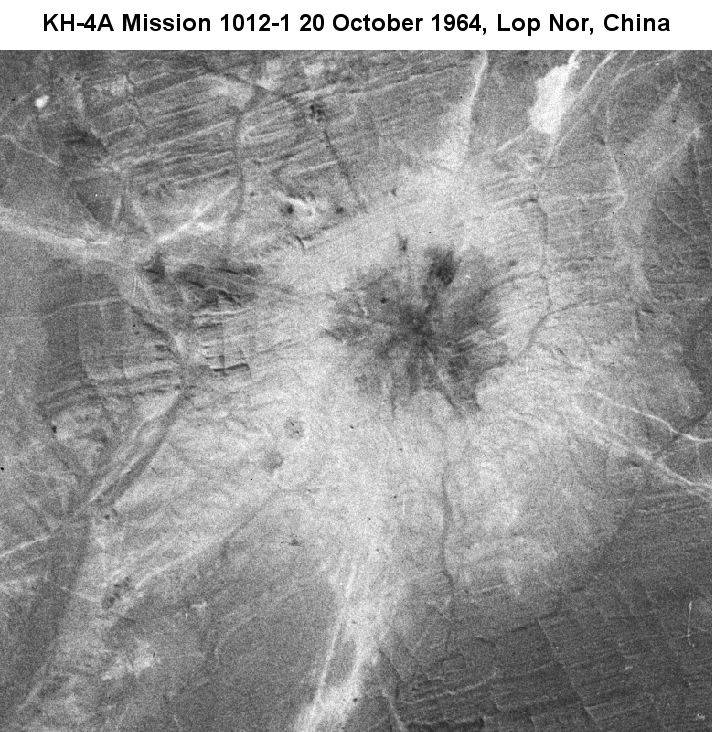
By the time of the first test, a quantity of fissile materials was accumulated in the PRC, sufficient to produce several more charges. Taking into account the fact that the Chinese nuclear scientists had at their disposal data on tests in the USSR and the USA, they largely followed the beaten track, which greatly facilitated and accelerated the work.
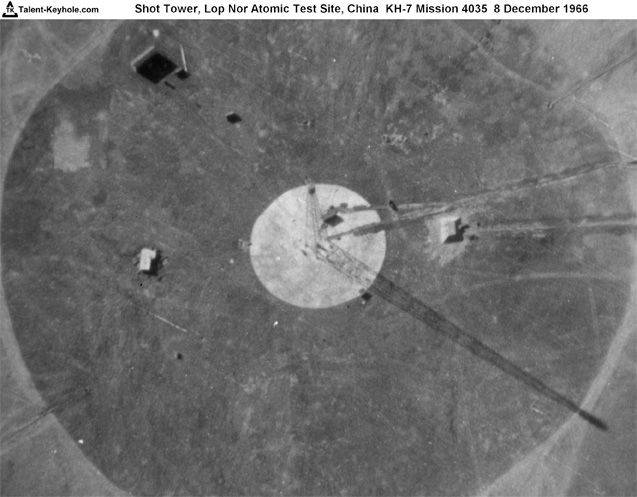
In addition to the first 16 explosion of October 1964, two more charges were exploded at the Lobnor test site on the towers. At the same time, Chinese specialists managed to quickly create a sample suitable for practical use.
14 May 1965, the first successful test of a combat model took place in Lobnor - a free-falling aerial bomb with a capacity of 35 CT. A uranium bomb dropped from a Tu-4 bomber exploded at an altitude of 500 m.
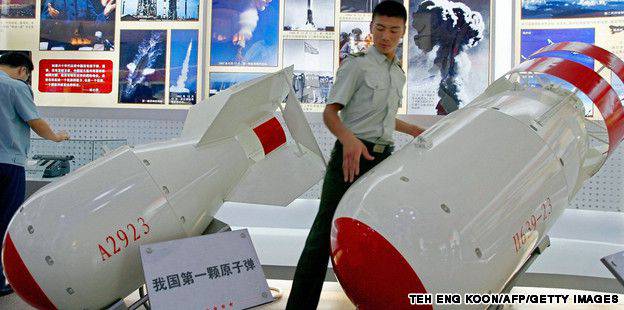
Back in the 1953, 25 from the USSR was supplied by the long-range piston bombers Tu-4, which, in turn, were an unlicensed copy of the American B-29. By the middle of the 60-s, they were hopelessly outdated, but, nevertheless, the aircraft of this type were operated in China until the beginning of the 80-s. More modern carriers were the jet front bombers Harbin H-5 (copy IL-28) and long-range bombers Xian H-6 (copy Tu-16), but they could perform mainly tactical tasks. Being vulnerable to modern air defense systems, these planes did not have the range necessary for hitting strategic targets.
Just three years after the test of the first nuclear device, 17 June 1967, a successful test of a Chinese thermonuclear bomb took place, which could be used for combat purposes. This time, the H-6 jet bomber was involved in the tests. The bomb exploded at an altitude of about 3 km, the power of the explosion was 3,3 Mt. At the end of December 1968, a test of a thermonuclear charge was carried out in China for the first time, using weapons-grade plutonium.
Thus, China became the fourth in the world after the USSR, the USA and the UK possessor of thermonuclear weapons, ahead of France for more than a year. It is indicative that the time interval between the creation of the atomic and hydrogen bombs in the PRC was smaller than in other countries.
At the Chinese site Lobnor 1100 square. km total 47 test nuclear explosions were carried out. Of these: 23 explosion in the atmosphere and 24 underground. The last atmospheric test in China took place in 1980 year, further tests were performed only underground. In July, 1996, China declared a moratorium on nuclear testing and signed the Comprehensive Nuclear-Test-Ban Treaty. But this treaty in the PRC has not yet been ratified, which leaves a loophole for further testing.
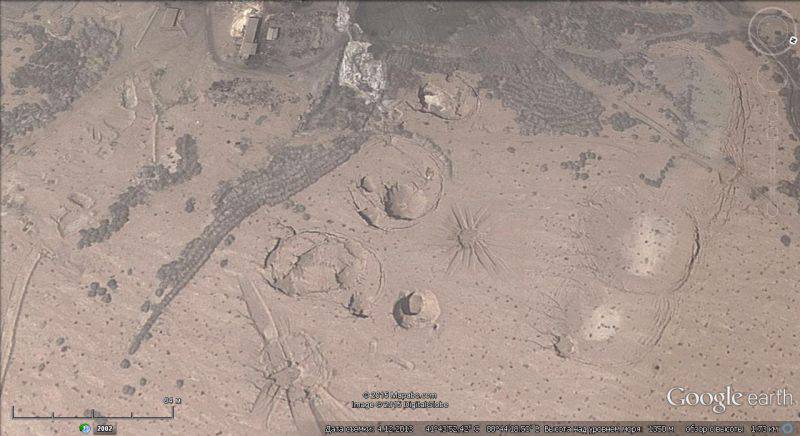
Google Earth snapshot: dips and craters at the Lobnor test site resulting from underground nuclear explosions
October 27 The 1966 of the Year in the PRC was a fairly risky test using nuclear weapons. The medium-range ballistic missile DF-2 (Dongfeng-2) was launched with a real nuclear charge of 20 CT. Having flown almost 900 km, she successfully hit a conventional target at the Lobnor test site.
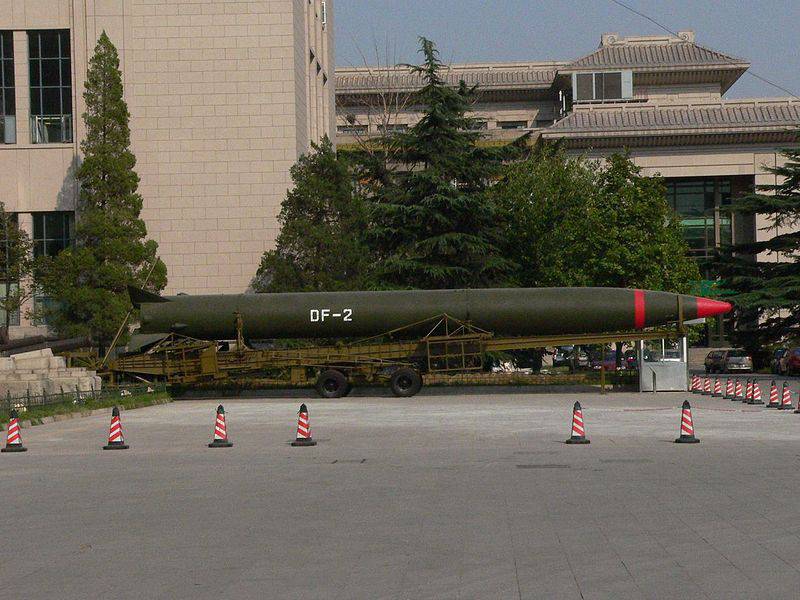
It is believed that when creating the liquid DF-2 MRBR, technical solutions of the Soviet P-5 rocket were used. To launch a rocket from a technical state of constant readiness, it took about 3,5 hours. Before transportation to the starting position, the missiles were stored in a concrete arch-type shelter. At the beginning of the 70-x missiles DF-2 equipped with a thermonuclear one-piece warhead power 700 CT. These missiles were deployed along the borders with the Soviet Union and Mongolia. According to the results of experimental test launches, their reliability coefficient was low - no more than 0,8, and the CSP when firing at the maximum range of 1250 km - about 3,5 km. Approximately 1979 DRF DF-70 and advanced DF-2A were on combat duty until 2.
In the first half of the 70-x, the PLA Second Artillery Corps received a single-stage MRSD DF-3 - from low-boiling LRE (oxidizer - nitric acid, fuel - kerosene), with a launch range of up to 2500 km.
At the time of the issuance of a technical project for development, the American targets in the Philippines, Clark and Subic Bay, were considered priority targets for the DF-3 missiles. But after the start of mass production, most of the BRSD was deployed along the Soviet-Chinese border.
In 1986, the production received an improved modification - DF-3A with a launch range of 2800 km (up to 4000 km with a lightweight head part). DF-3A was capable of hitting targets around 50% of the USSR. Currently, the PRC missiles DF-3 / 3А are removed from combat duty, but they are actively used in various kinds of tests created in China for early warning systems and missile defense.
Almost simultaneously with the DF-3, the so-called “Moscow missile”, the DF-4, began to arrive on combat duty. It had a lot in common with the DF-3, but was two-step. The launch range of the DF-4 BR was enough to “get” American bases in the Pacific Ocean and “sweep” the entire territory of the USSR. A missile of length 28 m and weighing more than 80000 kg, was able to hit a thermonuclear warhead with a power of 3 Mt, the target is at a distance of 4800 km.
DF-4 was the first Chinese missile to be placed in a protected mine. True, it was only kept there, before the launch the rocket was lifted by a special hydraulic lift onto the launch pad. Currently, all DF-4 removed from combat duty.
At the beginning of the 80-x, the first truly intercontinental three-stage heavy-duty ICBM DF-5 was adopted in the PRC. Asymmetric dimethylhydrazine is used as a fuel in the engines of the rocket, and nitrogen tetroxide is used as an oxidizing agent. The launch weight of the DF-5 is within 185-190 m. The missile carries a thermonuclear warhead with a capacity of up to 3 Mt, KVO at the maximum launch range - 13000 km about - 3,5 km. Objects throughout the USSR, the USA and Europe were within the reach of Chinese ICBMs.
According to its characteristics, the DF-5 ICBM roughly corresponded to the Soviet intercontinental missiles of the end of the 60-s. The preparation time for the launch of the DF-5 MBR from the moment of receiving the launch command is 20 minutes. The DF-5 rockets did not become massive, in the amount of about 20 units they were placed in silo at bases in the Xuanhua and Liaoning areas.
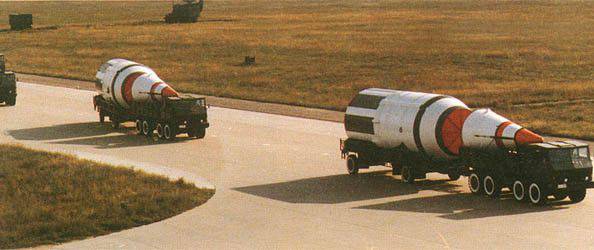
In the second half of the 80-x, the upgraded ICF DF-5А came into service. Its main difference from the early model was the introduction of a new warhead with blocks of individual guidance (MIRVI IN). The rocket carries up to five warheads with a charge power of 350 Kt, while the launch range decreased to 11000 km. A new astronavigational guidance system is provided by the KVO around 500. According to American sources, as of the beginning of the 21st century, the People's Republic of China built around 30 DF-5A missiles, while around 20 ICBMs were on combat duty.
A characteristic feature of the Chinese mine launchers is their excellent masking on the ground and the presence of numerous false positions. It is common practice to build light props over the top of the rocket mines, which are quickly demolished by the engineering services in the process of preparing the rocket for launch. Even knowing the areas of deployment, it is almost impossible to reliably determine whether it is a false position or a real one using satellite images. This is partly due to the small number of Chinese ICBMs, and the worst protection of silos in comparison with Russian and American missile mines, which made them vulnerable in the event of a sudden “disarming strike”.
Wishing to reduce the vulnerability of their strategic nuclear forces, in the People's Republic of China, as in the USSR, they took the path of creating mobile soil complexes. At the end of the 80-x, the PLA began launching a mobile launcher with the DF-21 MRBM. The new missile system first of all entered the missile regiments armed before that DF-3, replacing old types of liquid missiles.
The DF-21 rocket, weighing 15 t, is capable of delivering a single-piece 300 ct warhead to a range of up to 1800 km. Thanks to the progress in the field of radio electronics, Chinese designers have managed to create a new, more advanced rocket control system. Because of this, the CER was reduced to 700 m, which was a very good indicator in the 80-s. Combined with a powerful warhead, such accuracy allowed to solve most strategic tasks. Placing missiles on mobile off-road launchers provides the possibility of evading DF-21 MRBM from a “disarming strike” by means of air attack, cruise and ballistic missiles.
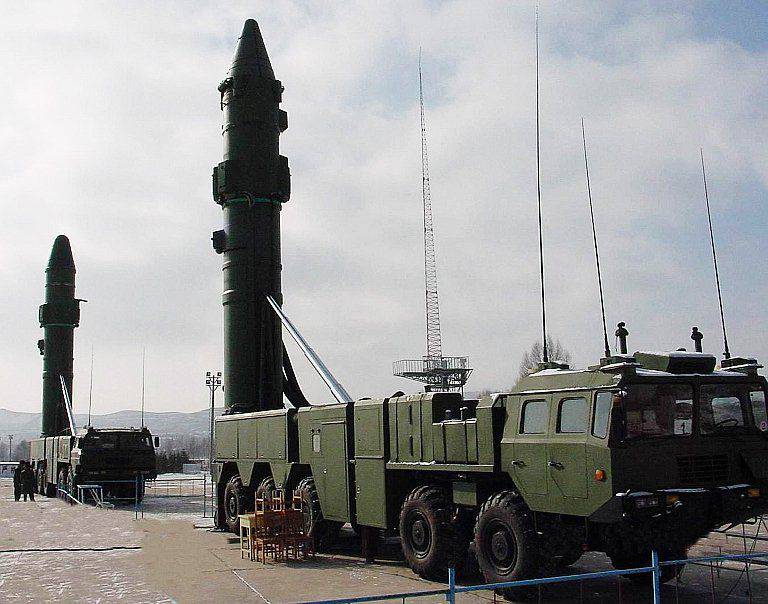
A further development option was the DF-21С, which entered service at the start of the 2000-x. On the upgraded rocket, the QUO is reduced to 500 m, and when used in hovering the warhead of the satellite positioning signals, the KVO is 40-50 m. As reported in the Chinese media, this accuracy allows the use of missiles for non-nuclear missions. Recently, a reference to a new version of the DF-21 complex with a launch range increased to 3500 km appeared in the PRC. Chinese MRBRs are practically useless in confrontation with the United States, but they cover a significant part of the territory of Russia.
If DF-21 is in some way a Chinese conceptual analog of the Soviet Pioneer medium-range RSD-10 complex (SS-20), then the DF can be considered an analogue of the Russian mobile soil complex Topol (SS-25) with a PC-12М rocket. -31.
The creation of a solid-fuel rocket for a mobile complex has become a serious achievement for Chinese designers. Thanks to the use of solid fuel on DF-31 rockets, the pre-launch preparation time was reduced to 15-20 minutes.
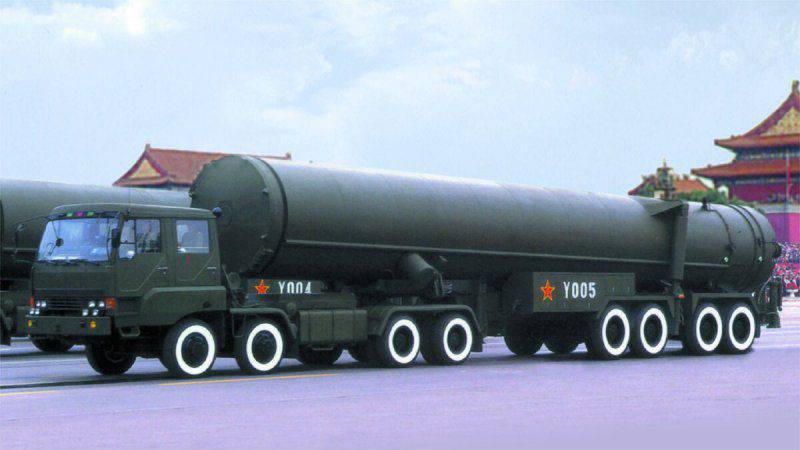
The first successful launch of the DF-31 took place in the 1995 year, but the tests were difficult, emergency situations occurred repeatedly, including with human victims. Apparently, the first DF-31 were produced in small quantities and were in trial operation. Approximately 10 years ago, satellite intelligence assets recorded in the central regions of China the beginning of the construction of concrete platforms for launching mobile ICBMs. They are designed for upgraded DF-31A missile systems with a launch range of more than 11000 km. The real characteristics of this missile are unknown, but according to American experts, the DF-31A can carry a single nuclear warhead with a capacity of up to 1 Mt, or three individual targeting warheads with 20-150 power, CVT is, according to various estimates, from 100 m to 1 km . According to the characteristics of the drop mass, the DF-31А roughly corresponds to the Russian Topol ICBM. But compared to the Russian mobile soil complexes DF-31, located on an eight-axle towed chassis, seriously inferior to them in all terrain. For this reason, Chinese missile systems are able to travel only on paved roads.
In September, 2014, a public demonstration of a new modification of the Chinese mobile missile system DF-31В took place. It is a further development of the DF-31A. In 2009, the open reference to the first mention of a new Chinese solid-fuel ICBM - DF-41. Supposedly, the DF-41 with mass-dimensional characteristics increased in comparison with other Chinese solid-fuel ICBMs is intended to replace the old DF-5 mine-based liquid missiles. According to Western experts, the new ICBM can have a launch range of up to 15000 km and carry a divided warhead containing up to 10 warheads and missile defense weapons. But, apparently, in the future, mobile soil complexes will be the basis of the strategic nuclear forces of China. It is known that the rocket bases of the DF-21 and DF-31 mobile complexes for the most part are located not far from the mountain ranges. A network of transport tunnels is equipped in these mountains, in which mobile launchers can hide from a preemptive nuclear strike. Of course, information about hundreds of kilometers of tunnels in the depths of mountains, which tens dozens of Chinese launchers roll over, most likely does not correspond to reality, but a tunnel with a length of 2-3 km with several disguised and reinforced exits for this purpose is sufficient. In this way, the strategy of “nuclear retaliation” is being implemented in the PRC. At present, the Chinese strategic nuclear forces are not capable of implementing counter-onslaught, but, according to the Chinese defense doctrine, the launching of nuclear counter-attacks by Chinese ballistic missiles can last for about a month, as the launchers gradually withdraw from the shelters.
It is obvious that the Second Artillery Corps of the PLA largely repeats the path made in its time by the Russian Strategic Missile Forces. At the end of 2015, it became known about the test in the PRC of the DF-41 rocket in the railway-based variant. Taking into account the fact that the length of railway tracks in the People's Republic of China exceeds 120 thousand km, the creation of a combat railway missile system seems to be quite justified. In the opinion of American intelligence, China acquired documentation on the railway missile system in Ukraine, where the Molodets Soviet BZHRK with the R-23 UTTH ICBM was developed at the Dnepropetrovsk Yuzhnoye design bureau.
In addition to the secrets concerning the Soviet BZHRK, the Chinese received from Ukraine X-55 cruise missiles, which were once armed with the strategic bombers Tu-160 and Tu-95MS, based near Poltava. On the basis of the X-55 in China, its own air-launched cruise missile CJ-10A with a nuclear warhead was created.
Up to six CJ-10A cruise missiles can be hung on the upgraded H-6K long-range bomber. This aircraft has greater combat effectiveness compared with early versions of the H-6. In addition to the new avionics and electronic warfare station, the upgraded bomber received the economical Russian D-30KP-2 engines, which made it possible to increase the range from 1800 to 3000 km, and the bomb load to 12000 kg.
However, by modern standards, even the modernized H-6K is, of course, an outdated machine. In this regard, several years ago, the Chinese leadership tried to agree on the supply from Russia of supersonic Tu-22М3 bombers, but was refused. It is known that, at present, two projects of the promising long-range bomber H-8 and H-10 are being developed at once in the PRC.
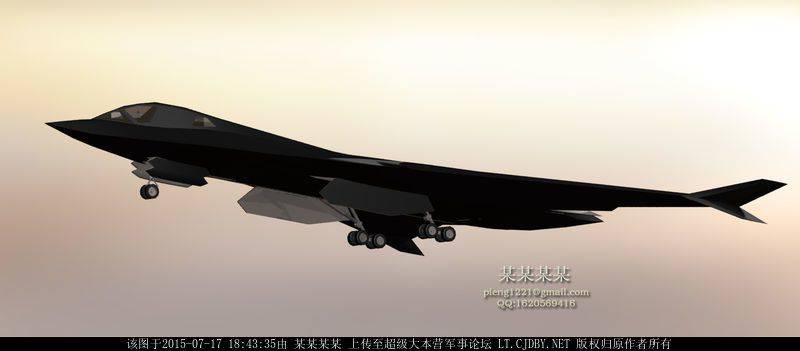
At the beginning of the current millennium, the PRC began to form the maritime component of the nuclear triad. Prior to this, the PLA Navy had a single SSNB of the 092 Pr “Xia”, which, in fact, was in trial operation and, due to low data and reliability problems, was not involved in combat patrols. In 2013, the boat of the 092 Pr. "Xia" was retooled for testing new missiles.
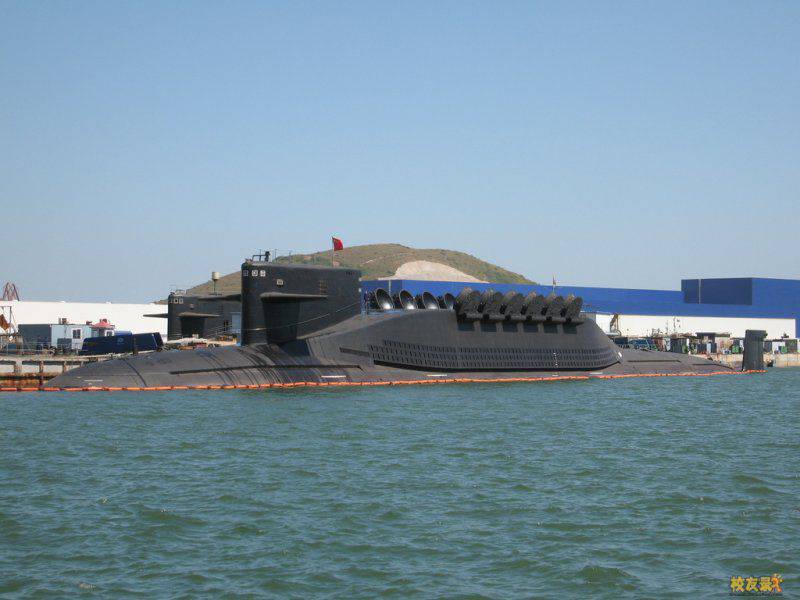
In 2004, the first Chinese SSBN of the new generation, 094 Jin, was put into operation. According to information published in the Chinese media, in 2011, the 6-I was launched on the account of a boat of this type. The main armament of submarines Ave 094 are 12 ballistic missiles (SLBMs) JL-2 with a launch range 8 000 km. Externally, the Chinese boats of the 094 Ave are very reminiscent of Soviet SSBNs of the 667BDRM Dolphin Ave.
According to American data, in 2014, the Chinese SSBNs of the 094 Ave began executing combat patrols, but so far it mostly takes place on its banks under the cover of surface forces and aviation.
On Chinese ropes, construction is being carried out on SSBNs of the 096 Pr. Teng with improved stealth characteristics. It is assumed that she will be armed with 24 SLBMs with a range of up to 11000 km. Given the growing economic power of the PRC, it can be assumed that by the year 2020, the PLA Navy will have at least 8 submarine rocket carriers Ave 094 and 096, with the 100 SLBM of intercontinental range. This roughly corresponds to the number of missiles on Russian SSBNs that are on duty personnel.
Special mention deserves the Chinese tactical nuclear weapons. For a long period, the main carriers of the Chinese tactical atomic bombs with a 5-20 kt were the H-5 bombers and the Q-5 attack aircraft. Currently, these aircraft as carriers of tactical nuclear weapons replaced by fighter-bombers JH-7A and J-16.
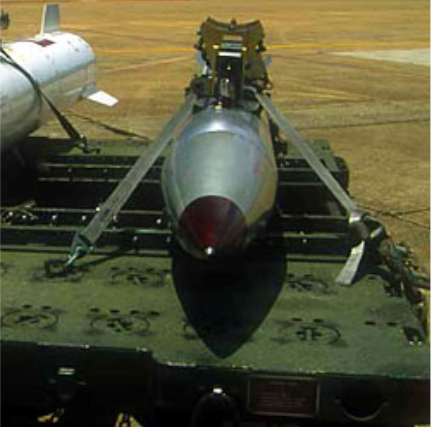
Information in open sources about the Chinese "nuclear artillery" is not, but work on this topic in the PRC were certainly conducted, and it is impossible to exclude the presence of large-caliber long-range artillery "nuclear projectiles" in service with large-caliber artillery. But in the PRC, not a single major military parade is complete without the demonstration of tactical and operational-tactical missile systems.
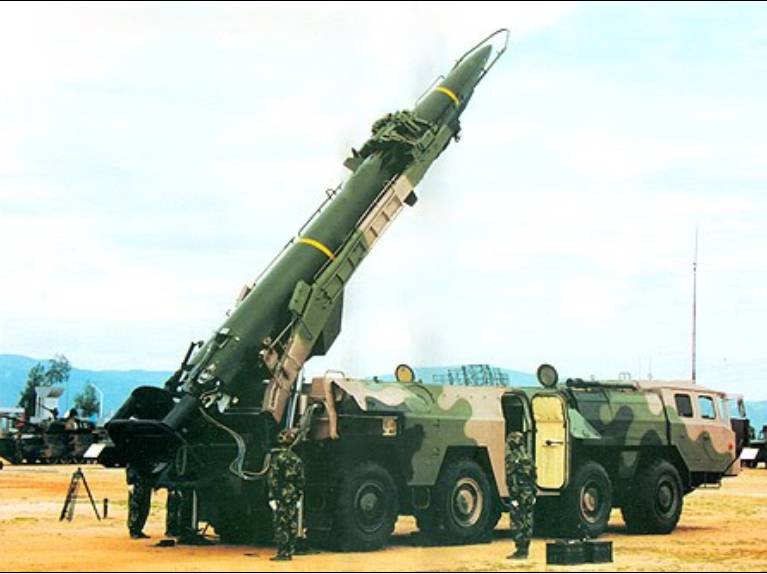
The first such DF-11 complex with a single-stage solid-fuel rocket entered service at the end of the 80's. The 4200 kg rocket is placed on a wheeled chassis, which strongly resembles the Soviet MAZ-543. The missile is equipped with an 500-kg warhead and has a launch range of up to 300 km. The upgraded version of the DF-11A with a range of 500 km entered service in the 1999 year. The number of PLA DF-11 / 11A in the PLA is estimated at 130 launchers, most of which are located near the Taiwan Strait.
At the beginning of the 90-x another OTRK entered into service - DF-15. A solid-fuel rocket complex weighing 6200 kg capable of delivering 500 kg warhead to a range of 600 km. An eight-wheel platform is used to transport the rocket, which provides high mobility and maneuverability of the complex. By the year 2000 in the People's Republic of China, about 200 OTRK DF-15 was produced.
In 2013, the military parade demonstrated the OTRK DF-15В. The external difference between the new complex was a rocket with a modified head, strongly resembling the American MGM-31C Pershing II. In China, OTRK of the DF-15 family are considered to be analogous to the Russian Iskander OTRK.
Another Chinese tactical nuclear delivery vehicle is the DH-10 ground-based cruise missiles (CRRF). They, as well as aviation CJ-10A, are based on Soviet X-55 received from Ukraine.
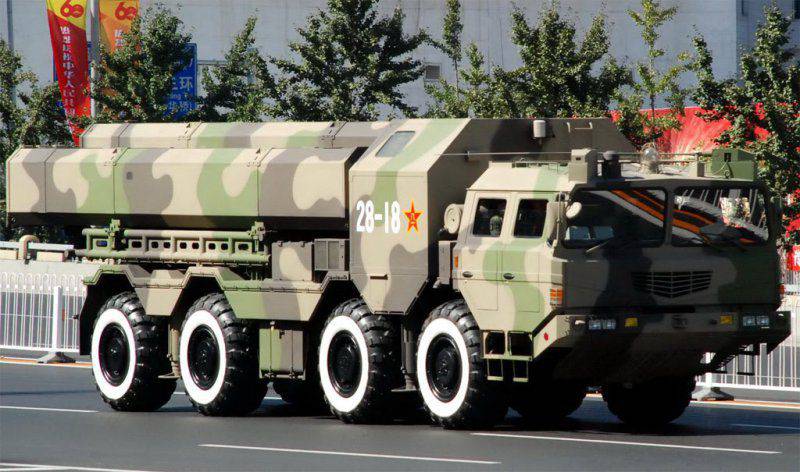
Adoption of the KRNB DH-10 occurred at the end of 2009. Three missiles in transport and launch containers are located on a four-axle all-terrain chassis. The same mobile launcher can be used to launch anti-ship missiles - YJ-62А with a launch range of 400 km. Thus, in the PRC there is a unified ground-based and air-based cruise missile, which, depending on the type of guidance system, is capable of striking enemy ships at a considerable distance from the coast and hitting ground targets with conventional and nuclear warheads. Most of the Chinese KRNB is located along the east coast of China, not far from Taiwan.
In addition to the listed carriers of nuclear weapons, the PRC has a number of tactical charges for torpedoes, depth charges and anti-aircraft and possibly anti-ship missiles. The total number of deployed strategic nuclear weapons of the People's Republic of China is estimated at approximately 250-300 units, it could be much larger, but so far limited by the number of carriers. In the coming 5 years, as new SSBNs and solid-propellant ICBMs with HSRP IN are commissioned, this figure may exceed 500 units. The number of Chinese tactical nuclear warheads by American intelligence is estimated at about the 300 warheads. In terms of the number of tactical nuclear weapons, the PRC is approximately at the same level as the United States and is somewhat inferior to Russia. But, unlike the Russian TNW stored mainly in the warehouses of 12 GUMO, most of the Chinese tactical charges are either installed on carriers (CR, OTR, Zour), or located in protected nuclear cellars and can be placed on carriers at any time (tactical nuclear bombs).
In the past, the production of nuclear warheads in the PRC was limited to a shortage of uranium ore. Own reserves of uranium ores in the country as of 2010 year were estimated at 48800 t, which, by Chinese standards, is clearly not enough. The situation changed in the middle of 90, when China was able to import raw materials for the nuclear industry from Africa and Central Asia.
According to Western expert estimates, the amount of plutonium obtained in the PRC to the end of 80-x was approximately 750 kg. This volume is quite enough for the production of several hundred nuclear bombs (3-5 kg of plutonium are contained in nuclear warheads). However, due to the fact that for a number of reasons, the lifespan of Chinese nuclear warheads in 70-80s was limited to 10s for years, there were relatively few warheads in service with the PRC. Production facilities allow the assembly of 70 nuclear charges per year.
In 80-90, France made a major contribution to the development of Chinese atomic energy. The CPR-1000 power reactors, first launched at the Guangdong NPP, are a China version of Areva’s CPY reactor. Plutonium is a by-product of the CPR-1000 reactors. As of November 2015, the 31 industrial nuclear reactor operated in the PRC.
At present, weapons-grade plutonium in the PRC is being produced at enterprises in Jiuquan, Gansu Province and Guangyuan Province, Sichuan Province. The exact amount of plutonium produced in the PRC is not known, but, according to estimates by the Global Security Institute (GSI), it has been obtained about 60 kg since the middle of the 2500-s. This volume is sufficient for assembling 600 warheads.
Based on:
http://nuclearweaponarchive.org/China/ChinaTesting.html
http://nsarchive.gwu.edu/nukevault/ebb488/
http://scienceandglobalsecurity.org/archive/2003/01/estimating_chinas_production_o.html
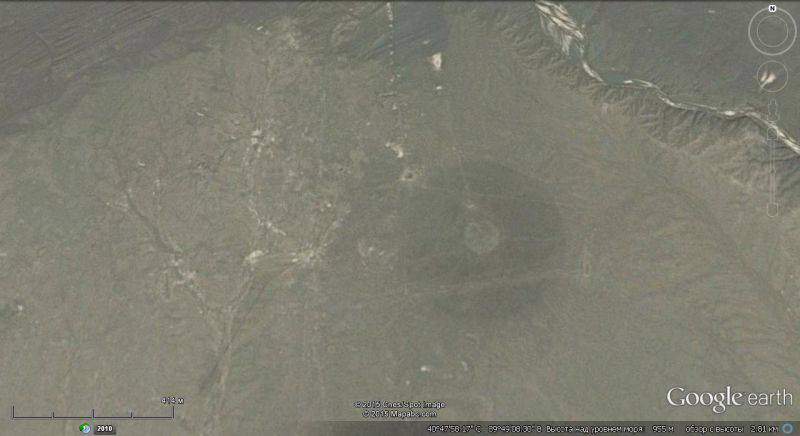
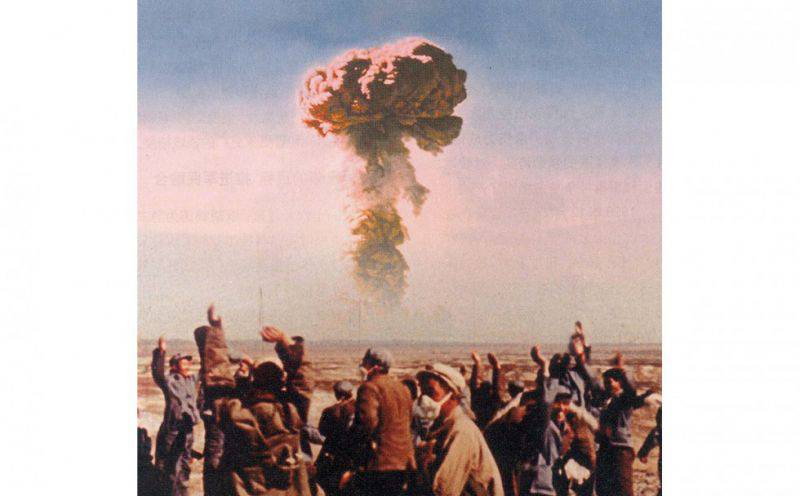
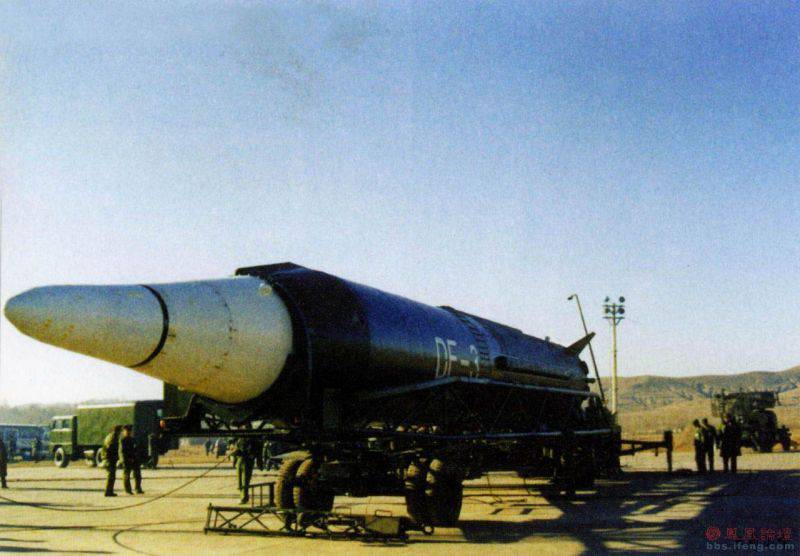
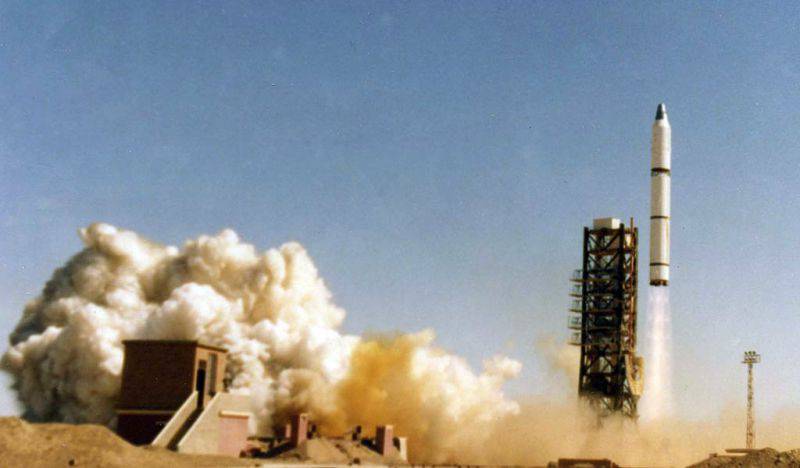
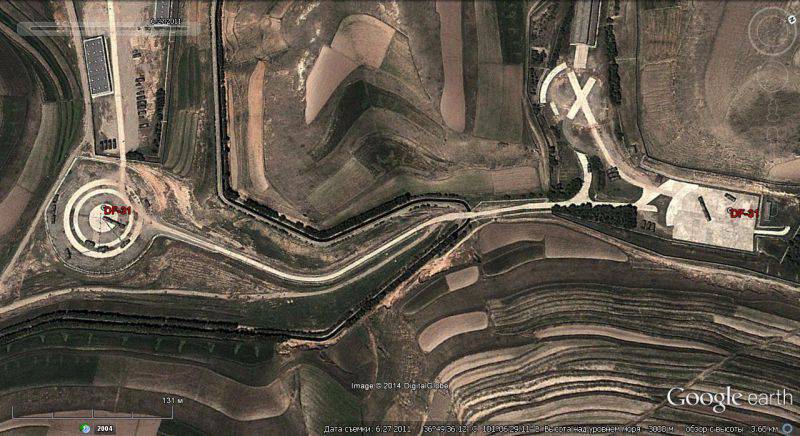
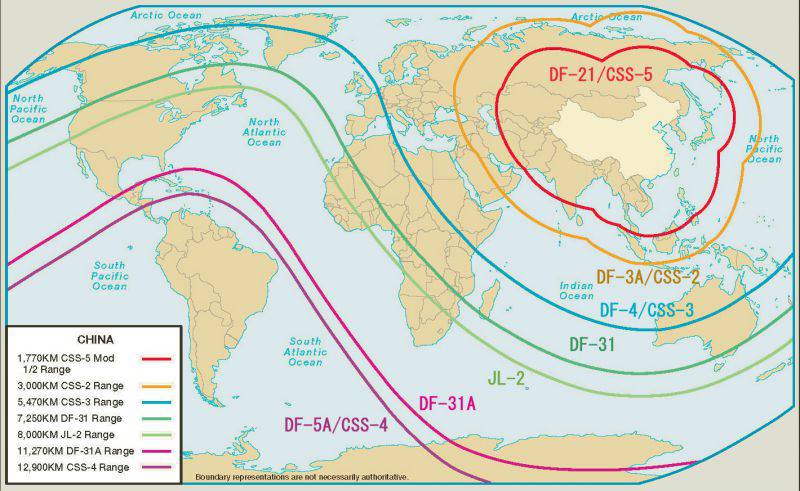
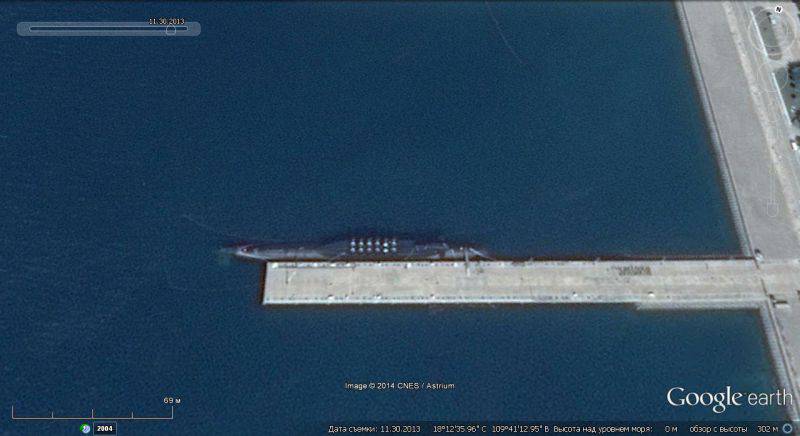
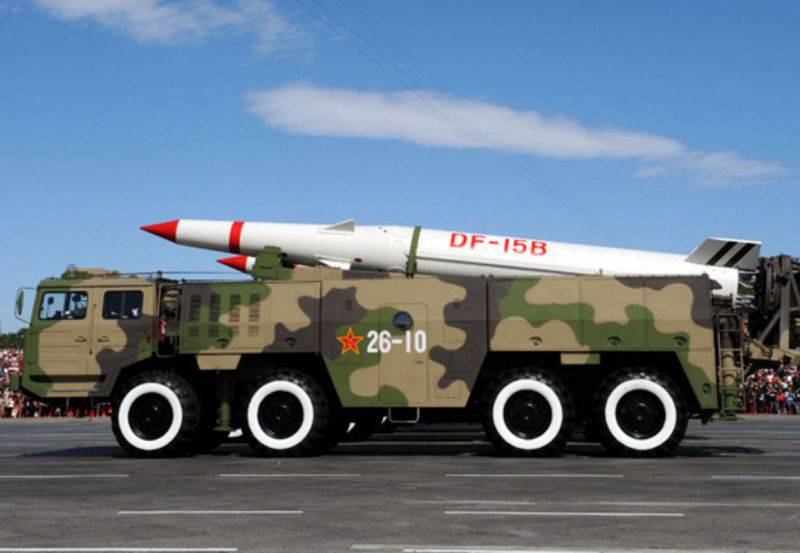
Information